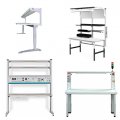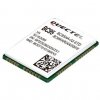Diese Technologie fällt in den „Low Power Wide Area Network“ (LPWAN)-Bereich, in dem unter anderem das berühmte SIGFOX-Netz, der LoRa-Standard und viele weitere Spezifikationen Anwendung finden.
Zu den wichtigsten Vorteilen dieser Technologien zählen:
- Geringer Stromverbrauch (ideal für batteriebetriebene Geräte mit einer Betriebsdauer von bis zu 10 Jahren)
- Geringes Datenübertragungsvolumen
- Module mit geringer Größe
- Lange Reichweite von bis zu 15 km
- Gute Hindernisüberwindung
In dieser Abbildung sind die wichtigsten Unterschiede zwischen Technologien dargestellt, die für die drahtlose Datenübertragung verwendet werden. GSM/GPRS-Module beispielsweise haben im Standby-Modus einen Stromverbrauch von etwa 10-15mA, das BC95 hingegen verbraucht lediglich 5uA. Dies ist ein immenser Unterschied und ermöglicht, dass das BC95 für bis zu 10 Jahre über Batterie betrieben werden kann.
Empfohlene Anwendungsbereiche für NB-IoT-Module:
Energie
a) Strommessung
b) Gasmessung
c) Wassermessung
d) Wärmemessung
e) Smart Grid
f) Windturbinen
g) Solaranlagen
h) Ladesäulen
Smart City
a) Straßenbeleuchtung
b) Verkehrsbeleuchtung
c) Aufzug
d) Digitale Beschilderung
e) Werbe-Display
f) LED-Beleuchtung
g) Garbage-Bin-Monitoring
h) Parken
Es handelt sich hierbei um eine grundlegende Beschreibung und einen Vergleich der LPWAN-Technologien.
Im Folgenden steht allein das Modul BC95 im Fokus.
Quectel bietet 3 Basisvarianten, die in verschiedenen Frequenzbändern arbeiten:
BC95-B5 (850MHz)
BC95-B8 (900MHz)
BC95-B20 (800MHz)
All diese Module sind mechanisch kompatibel und weisen dieselbe Funktionalität auf. Darüber hinaus sind diese mit dem GSM/GPRS-Modul M95 Pin-kompatibel. Weitere Informationen zur Kompatibilität von Modulen finden Sie hier Quectel_BC95&M95 R2.0_Compatible_Design_V1.1.
Die Versorgungsspannung liegt in einem Bereich zwischen 3,1 und 4,2 V, die Versorgungsspannung beträgt typischerweise jedoch 3,8 V. Erfahrungsgemäß gehen manche Kunden davon aus, dass das Modul bei 3,1 V betrieben werden kann, wenn die Batteriespannung allerdings unter 80 % der Nennspannung einer LiSoCl-Batterie fällt, stellt das Modul den Betrieb ein. Aus diesem Grund gilt es die Herstellerangaben zur typischen Spannung sowie zum Batterieleben zu beachten.
Die Batteriennutzung hängt von der jeweiligen Anwendung ab. Berücksichtigen Sie dementsprechend bitte, welche Batterien verwendet werden. Wir empfehlen, falls dies erforderlich ist, die Verwendung qualitativ hochwertiger LiSoCl-Batterien wie bspw. von XENO aus unserem Sortiment.
Weitere Informationen, ein Schaltdiagramm sowie eine vollständige Dokumentation zu den BC95-Modulen und weiteres mehr finden Sie auf der BC95-Dokumentationsseite.
Gefallen Ihnen unsere Artikel? Verpassen Sie jetzt keine mehr! Sie müssen sich um nichts kümmern, wir arrangieren die Lieferung an Sie.

























